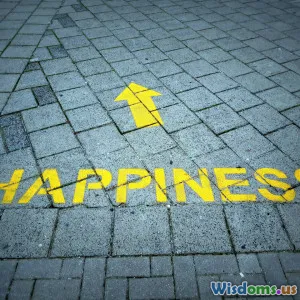
Unlocking Better Friendships By Embracing Solitude
34 min read Discover how intentional alone time strengthens self-awareness, emotional regulation, and communication, leading to deeper, healthier friendships—with practical exercises, boundaries, and science-backed tips for introverts and extroverts. (0 Reviews)
Unlocking Better Friendships By Embracing Solitude
Most friendship advice focuses on being more present, more generous, more communicative. That is half the story. The other half begins when you are alone. Counterintuitive as it seems, solitude is one of the most reliable ways to become a better friend: the quiet is where you learn your own contours, align your values, and return to people with clarity, patience, and warmth.
This article is a practical guide to using solitude to strengthen your relationships. You will learn why time alone improves social skills, how to design solitude you will actually keep, and how to translate insights into concrete conversations. Think of it as a bridge: one end anchored in your inner life, the other in the everyday rituals that make friendships durable.
Why Solitude Makes You a Better Friend

Solitude is not social withdrawal. It is chosen time with yourself, free from the immediate pull of other people, noise, and notifications. Here is why that matters for friendship quality:
- Better self-knowledge. Friends cannot read your mind. When you regularly step back to notice what energizes you, what depletes you, and what you actually need, you reduce mixed signals and resentments. People with higher self-concept clarity tend to navigate conflicts more effectively because they are less reactive and more coherent in what they communicate.
- Emotional regulation. Solitude gives your nervous system a chance to downshift. Quiet activities like mindful walking, slow breathing, or journaling can lower physiological arousal. When you later face a sensitive conversation, you arrive with more bandwidth and fewer spikes.
- Empathy through perspective-taking. Time alone frees cognitive resources for reflection. Studies on self-distancing suggest that when we step back from immediate feelings, we are more capable of considering other perspectives. Practicing this in solitude makes empathy more accessible during real interactions.
- Stronger boundaries. Boundaries are not walls; they are edges. In solitude, you can rehearse clear, kind statements about your limits. That clarity prevents silent scorekeeping and late-stage blowups.
- Creativity and playfulness. The default mode network of the brain is active during restful mind-wandering and is linked with creative insight. Friends benefit from your ideas, humor, and novel plans that often originate in those unstructured minutes you give yourself.
A short example. Imagine Sam, who often agrees to weeknight plans and then bails, leaving friends frustrated. After a month of scheduled solitude blocks, Sam realizes it is not the plan that is the problem but the timing. Workdays drain Sam, while Saturday mornings feel open and bright. Sam updates friends: weekday evenings are off the table, but Saturdays are fair game. Cancellations drop, attendance rises, trust returns.
From Alone to Aligned: A Practical Framework

Use this ALIGN framework to turn solitary minutes into social impact:
- Assess: Scan your current social life. Which friendships feel nourishing, neutral, or draining? Where are you overpromising? Where are you hiding?
- Listen: Sit with your body for 5 minutes. What sensations show up when you think about each friendship? Tight chest equals anxiety; lightness equals ease. Your body keeps score.
- Identify needs: Choose one core need for each key friendship: more depth, more frequency, more fun, more space, or clearer boundaries.
- Grow one skill: Pick a single micro-skill to practice this week, such as asking better follow-up questions, voicing gratitude, or politely declining.
- Network intentionally: Translate your insight into a concrete action that honors your need and respects the other person.
How to run ALIGN in 25 minutes once per week:
- Timer for 5 minutes. Assess by writing two short lists: keep doing and change. Limit each to three items.
- Timer for 5 minutes. Listen by doing a simple breath check-in: inhale for 4, exhale for 6. Then write three sensations you noticed.
- Timer for 5 minutes. Identify one need per friendship. Keep it simple: more depth with Priya, more fun with Leo, more space with Ana.
- Timer for 5 minutes. Grow one skill by writing the exact sentence you will try this week. Example: Priya, I loved our museum day. Could we do a monthly deep-dive hang where phones stay in bags?
- Timer for 5 minutes. Network intentionally by scheduling or sending one message that aligns with your insight. Keep it specific and kind.
This brief ritual keeps solitude from becoming vague navel-gazing. You exit with a plan.
Designing Solitude That Sticks (Without Becoming a Hermit)

You do not need a cabin in the woods. You need repeatable pockets of low input and high intention. A few design principles:
- Micro over marathon. Ten daily minutes beat one monthly afternoon. Consistency builds self-knowledge and lowers the re-entry friction to social life.
- Make it visible. Put solitude on your calendar with a name you like: Reset, Quiet Lab, or White Space. Treat it like any other commitment.
- Stack it. Pair solitude with a routine you already do: the walk to the store, morning coffee, or an existing workout cooldown.
- Build a corner. A chair by the window, a park bench along your commute, or the last seat on the train. Reserve it for quiet time; no scrolling allowed.
- Choose a ritual opening and closing. Light a candle, set a 5-minute hourglass, or play the same instrumental track to start. Close by writing one sentence that names what mattered.
Examples:
- The 30-3-1 rule: Spend 30 minutes offline, answer 3 questions about your week, and send 1 message to a friend that reflects your answers.
- Commute capsule: Noise-canceling on, eyes soft, notice five colors you pass. Ask yourself: What do I want to remember from today? End by sending a gratitude text to someone who contributed to that moment.
- Nature wedge: If there is daylight, spend 12 minutes outside at a gentle pace. Research links even short nature exposure with mood improvements. Bring the same question each time: Where did I act on my values today?
The goal is not to withdraw, but to establish a steady pulse of quiet that lets you re-enter social spaces with intention.
What to Do During Solitude: 10 High-Return Practices

Not all alone time is equal. Doomscrolling does not cultivate empathy. Try these practices, each paired with a friendship upside and a quick how-to.
- Reflective journaling
- Upside: Improves emotional granularity, which helps you communicate specific feelings rather than broadcasting vague frustration.
- How-to: Use the prompt I felt X when Y happened because Z matters to me. Example: I felt tense when the group switched plans, because predictability matters to me.
- Compassion meditation
- Upside: Increases warmth and reduces judgment. Studies have associated compassion practices with greater prosocial behavior.
- How-to: For 5 minutes, silently repeat: May I be patient. May I be at ease. Then extend: May my friends be safe. May they feel cared for.
- Social debrief
- Upside: Turns awkward moments into learning. You stop ruminating and start iterating.
- How-to: After a hang, jot three bullets: what went well, what I wish I did differently, what I will try next time.
- Values map
- Upside: Deepens alignment. Friends can rely on you when your choices track your values.
- How-to: List your top five values in the margins of your week. Next to each event, mark which value it served. Notice gaps.
- Gratitude micro-note
- Upside: Gratitude strengthens relationships by reinforcing positive cycles of attention.
- How-to: Choose one friend. Write a 2-sentence note about a small thing they did that mattered. Send it as a text or voice note.
- Restorative nap or stillness
- Upside: Better sleep correlates with improved mood and less reactivity. Rest makes you kinder.
- How-to: Lie down for 15 minutes. Eyes closed. No media. Let your mind wander. When done, write one sentence naming your current energy level.
- Curiosity rehearsal
- Upside: More interesting conversations. You arrive with good questions.
- How-to: Write two questions each for three friends that go beyond How are you. Examples: What has been the most surprisingly good 15 minutes of your week? What are you saying no to this month?
- Letter you will not send
- Upside: Clears static around resentments without risking a reactive message.
- How-to: Write the unfiltered letter. Then write a second version that focuses on needs and requests. Only send the second one if it still feels right a day later.
- Digital declutter sprint
- Upside: Fewer phantom notifications and less fragmented attention when you are with people.
- How-to: In 10 minutes, unsubscribe from three email lists, mute three noisy group chats, and turn off nonhuman app badges.
- Slow hobby
- Upside: Hobbies restore a sense of competence and joy, which you bring back to your friends.
- How-to: Choose a tactile practice that cannot be rushed: sketching, sourdough, woodworking, or learning a song. Keep a bag ready to make it easy to start.
Choose two or three of these practices and rotate weekly. The repetition will compound.
Translating Solitude Into Stronger Friendships

Solitude generates insight; friendship requires action. Use these bridges.
- Clear invitations. Instead of We should hang, try: Want to take a 30-minute walk on Saturday at 10 near the lake? Clarity turns maybe into yes or no.
- Appreciations that land. Swap generic compliments for specifics: I felt really seen when you asked that follow-up about my job change. Thanks for taking the time.
- Boundary scripts. Practice gentle boundaries out loud. A few templates:
- The pause: I want to give this the attention it deserves. Can I call you tonight instead?
- The preference: I am best for calls on weekends. Weeknights I go quiet by 8.
- The no with alternative: I cannot do the concert, but I can do brunch next weekend.
- Repair after friction. When something goes sideways, use the ABC formula: Acknowledge impact, Briefly explain, Commit to change. Example: I see I went quiet after your message, and that felt dismissive. I got overwhelmed. Next time I will reply with a quick note that I need more time to think.
- Rituals of connection. Translate your values into repeatable rituals: Sunday voice notes, birthday letters, quarterly day trip, or a shared spreadsheet of places to try.
One more micro-bridge: end solitude by choosing one friend and one act within 24 hours. Send a photo from your walk, share a song, or drop a sincere check-in. Tie reflection to relationship with a small, consistent thread.
The Science (In Plain English)

Several research streams help explain why solitude can strengthen friendships when practiced with intention.
- Rest and the brain. During quiet rest, the brain shifts toward networks associated with self-referential processing and memory integration. This downtime helps you make sense of experiences and supports the kind of narrative coherence that makes conversations richer and more grounded.
- Self-distancing and emotion. Experiments on self-distancing suggest that stepping back from immediate emotion can reduce rumination and support wiser decisions. In solitude, simple techniques like talking to yourself in the third person can create that distance and ease future conflict.
- Compassion and relationships. Studies on compassion and loving-kindness practices have found associations with increased positive affect and prosocial behavior. Practicing compassion alone can translate into gentler tone and more patience with friends.
- Nature and stress. Short bouts of time in nature have been linked to improvements in mood and reductions in stress markers. Lower stress makes it easier to listen, hold boundaries, and stay open during tricky conversations.
- Phones and presence. Research has shown that the mere presence of a phone on the table can reduce perceived conversation quality and closeness. Solitude that reduces compulsive checking can retrain your attention, so the people in front of you feel truly met.
- Loneliness versus chosen solitude. Loneliness is a distressing feeling of disconnection; chosen solitude is neutral or positive. Findings consistently show that loneliness correlates with worse health outcomes, while restorative solitude can be protective when balanced with healthy connection.
You do not need a lab to use these insights. Design low-input moments; practice perspective-taking; move your body in green spaces; put the phone away when you are with people.
Solitude vs. Loneliness: Spot the Line Early

Solitude is restorative. Loneliness is painful. They can look similar from the outside, so learn to read the signals.
Signs your solitude is healthy:
- You choose it and can also choose to reconnect.
- You feel calmer or clearer afterward.
- You look forward to sharing what you discovered.
Signs loneliness is creeping in:
- You want to reach out but delay because it feels awkward or futile.
- Your sleep or appetite changes, or your energy collapses.
- Humor fades, and small hassles feel heavy.
If the second set dominates for more than a couple of weeks, it is time to adjust. A few gentle correctives:
- Create a connection floor. Define a minimum weekly contact: two messages, one call, or one in-person micro-meet. Keep the bar low and consistent.
- Use active invites. Propose a specific time and activity within the next seven days.
- Recruit a buddy. Share that you are rebuilding your social rhythm. Ask for a recurring check-in for a month.
- Get support. If loneliness feels sticky and heavy, consider speaking with a counselor or joining a group activity with structure, such as a class or club.
Healthy solitude refuels connection. If it starts to feel like a sinkhole, treat it as a signal, not a verdict.
For Different Personalities and Life Stages

- Extroverts. You recharge with people, but you still benefit from short, purposeful solitude. Try two 10-minute resets per day to plan and debrief, then bring your renewed energy back to the group.
- Introverts. Protect longer stretches of quiet, and set clear expectations with friends about your response times. Send warm, preemptive notes: I go quiet after 8 most nights. If you need me urgently, call twice; otherwise I will reply in the morning.
- Highly sensitive people. Reduce sensory input during solitude: dim light, soft sound, and physical comfort. When social, choose venues with manageable stimulation.
- Neurodivergent folks. Use solitude to script social scenarios and clarify needs. Write or voice-memo what you want to say; bring notes if it helps. Group chats can be turned into asynchronous check-ins.
- Parents and caregivers. Schedule micro-solitude linked to existing routines: the first five minutes after the school drop-off, the kettle boiling, or stroller laps. Ask one friend for a predictable monthly date so you are not relying on last-minute logistics.
- Remote workers. Build a daily end-of-work ritual: close tabs, 5-minute walk, three-sentence debrief. Then switch contexts by sending one friendly note before you log off.
- Students. Use campus geography: study in a quiet corner, take a solitary lap around a green space before group events, and send a quick anchor message to a friend to follow up afterward.
Different rhythms, same principle: solitude is most effective when it is predictable and paired with clear communication.
Digital Boundaries That Protect Both Solitude and Friendship

Devices compress private time and scatter attention. A few simple settings can restore both.
- Notification audit. Turn off badges and push alerts for everything nonhuman. Keep calls, messages, and calendar. Batch everything else.
- Status messages. Use status indicators to signal availability: On deep work until 3; back later. This reduces misunderstandings when you do not reply quickly.
- Do Not Disturb windows. Schedule recurring quiet windows each day. Share them with close friends so they know you are not ignoring them.
- App placement. Put social apps on the second screen in a folder named Intention. The extra step gives your brain a chance to choose.
- Device-free zones. Make the dinner table and the first and last 20 minutes of your day phone-free. Place your charger outside the bedroom.
- Group norms. Suggest a group norm for your friend circle: phones face down during meals, quick photo then back away, or one person designated camera so the rest can relax.
When you do meet, your attention will feel like a gift, not a scarce resource.
A 30-Day Starter Program
Use this four-week plan to build a solitude-to-friendship loop. Keep a single page to track it. All prompts take 10 to 20 minutes.
Week 1: Clarity and calm
- Day 1: Set your solitude schedule. Two 10-minute slots daily. Pick your ritual open and close.
- Day 2: Journal three relationship wins from the past month. What made them work?
- Day 3: Nature wedge for 12 minutes. Send one gratitude note afterward.
- Day 4: Digital audit for 15 minutes. Remove three noisy notifications.
- Day 5: Compassion practice for 5 minutes. Then write one sentence about a friend’s recent effort and send it.
- Day 6: Social debrief after your next hang. Identify one micro-skill to try.
- Day 7: Rest. No goals. Notice energy changes.
Week 2: Boundaries and invitations
- Day 8: Write your boundary scripts. One for timing, one for money, one for energy.
- Day 9: Practice out loud. Adjust wording until it sounds like you.
- Day 10: Send one specific invitation within the next seven days.
- Day 11: Letter you will not send about a small irritation. Write it, then rewrite it as a needs-and-requests message. Decide whether to share.
- Day 12: Create a connection floor: define your weekly minimum contact.
- Day 13: Phone presence rule for gatherings. Share with friends kindly.
- Day 14: Reflect on what felt easier or harder. Adjust next week accordingly.
Week 3: Depth and play
- Day 15: Values map your week. Name one mismatched obligation to gracefully exit.
- Day 16: Curiosity rehearsal. Write two questions each for two friends.
- Day 17: Plan a low-cost, high-play hang: board games, neighborhood photo walk, or cook-together night.
- Day 18: Slow hobby for 20 minutes. Send a progress pic to a friend who would enjoy it.
- Day 19: Gratitude micro-note to someone you have not spoken to in a while.
- Day 20: Social debrief. Note what brought laughter and ease.
- Day 21: Rest or catch-up day. Keep the floor.
Week 4: Repair and resilience
- Day 22: Identify one small repair opportunity. Use the ABC formula.
- Day 23: Compassion practice, then check in with a friend who is struggling. Ask a clear, easy-to-accept question: Would a 20-minute call tonight help?
- Day 24: Group norm nudge: propose a device-free dinner or a shared ritual.
- Day 25: Nature wedge with a friend. Each person names one thing they want more of this season.
- Day 26: Adjust your solitude schedule for sustainability next month.
- Day 27: Write a one-page reflection on what solitude changed in your friendships.
- Day 28: Celebrate with a small ritual: favorite dessert, slow coffee, or a scenic walk.
- Day 29–30: Buffer days. Repeat any exercise that felt especially helpful.
Repeat the program or keep the elements that stuck. The aim is a light, durable rhythm, not a forever checklist.
Mini Case Studies: How Solitude Repaired Real Friendships

- Case 1: The chronic fixer. Maya always tried to solve friends’ problems and noticed people stopped confiding in her. In solitude, she realized advice-giving was her way to manage anxiety. She practiced a three-question sequence: Do you want to vent, brainstorm, or be distracted? Within a month, two friends said they felt more comfortable opening up. The friendship climate changed from performance to presence.
- Case 2: The invisible friend. Jorge kept showing up to others’ events but never initiated. Weekly solitude helped him see a belief that invites are presumptuous. He wrote and practiced one script: I love how you plan hikes. Would you be up for switching it up and letting me host a curry night next Friday? Three yeses later, Jorge’s identity shifted: not just reliable, but generative.
- Case 3: The late reply pattern. Lina often read messages and thought, I will respond properly later. Later became never. After one social debrief, she wrote a rule: send a quick acknowledgement if the full reply needs time. Two words and an emoji when busy, full reply within 48 hours. Her friends reported feeling less ghosted, and she felt less guilt. Solitude turned into a system.
Questions to Ask Yourself Before You Text Back

Use this 30-second check to reduce misfires and match your response to your values.
- What is my current energy level, 1 to 10? If it is under 3, consider acknowledging now and replying fully later.
- What is the intention of my reply: to connect, to clarify, or to conclude? Choose one.
- Am I reacting to a story I wrote in my head, or to the actual words on the screen?
- If this message were read aloud in a room, would my tone still feel kind?
- What is the smallest honest step I can take that respects both of us: a question, a boundary, an appreciation, or a specific plan?
These questions inject a tiny pause between impulse and action. That pause is the hidden engine of better friendships.
Common Pitfalls and How to Avoid Them

- Turning solitude into scrolling. If you leave your phone within reach, your brain will grab it. Solution: change the environment, not your willpower. Put the phone in another room, or use a simple kitchen timer and airplane mode.
- Ruminating instead of reflecting. Reflection asks, What can I learn; rumination asks, What is wrong with me. Solution: time-box deep dives to 15 minutes and end with one action you can take.
- Moralizing solitude. Alone time is not morally superior to social time. If you start judging friends for being busy or loud, check yourself. Solution: practice compassion and remember that different nervous systems need different inputs.
- Over-scheduling quiet. Solitude is a means, not the goal. If your calendar becomes a fortress, you may be avoiding vulnerability. Solution: keep the connection floor and schedule at least one playful, people-rich plan each week.
- One-sided insight. You might have learned something important about your needs, but friendships are co-created. Solution: ask, How does this land for you, and be willing to adjust.
Pitfalls are not failures; they are signals to recalibrate. The fix is usually small.
Keep It Human: Warmth, Play, and Surprise

Solitude can sharpen your edges or soften your presence. Aim for the second. Friends do not want a perfect version of you; they want a present one. Bring warmth to your experiments.
- Leave a small surprise. Mail a postcard after your next solo museum visit, or send a song that matched your walk.
- Name the good in real time. When your friend cracks a joke that dissolves tension, say it out loud: That just made my day.
- Protect play. Use solitude to plan a simple game, route, or taste test. The friend who brings fresh play keeps groups alive.
- Keep curiosity alive. Enter hangs with one genuine question. Your friends are changing as fast as you are; let your attention reflect that.
Imagine your social life as a garden. Solitude is the quiet tending: checking soil, trimming, watering. Friendship is the bloom and the shade. Balance the two and you get sturdier plants, longer seasons, and more color.
If you try only one thing from this guide, try the 30-3-1 rule this week: 30 minutes offline, 3 honest answers about your life, 1 thoughtful outreach. Watch what changes. The richest friendships rarely come from always being together; they come from returning to each other a little more whole.
Rate the Post
User Reviews
Popular Posts
















